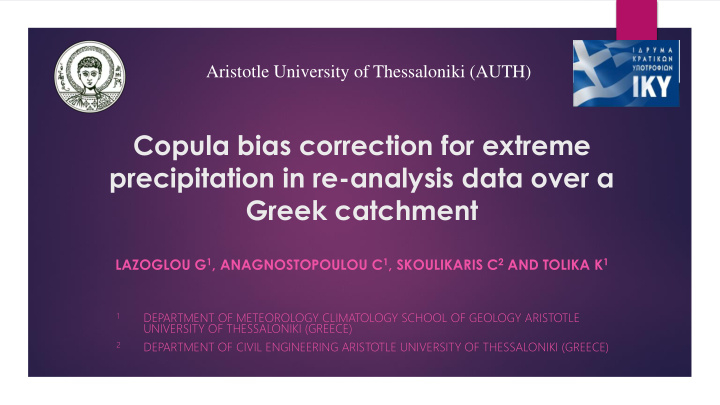



Aristotle University of Thessaloniki (AUTH) Copula bias correction for extreme precipitation in re-analysis data over a Greek catchment LAZOGLOU G 1 , ANAGNOSTOPOULOU C 1 , SKOULIKARIS C 2 AND TOLIKA K 1 1 DEPARTMENT OF METEOROLOGY CLIMATOLOGY SCHOOL OF GEOLOGY ARISTOTLE UNIVERSITY OF THESSALONIKI (GREECE) DEPARTMENT OF CIVIL ENGINEERING ARISTOTLE UNIVERSITY OF THESSALONIKI (GREECE) 2
Introduction Extreme precipitation episodes result in severe socioeconomic impacts. Their projection with higher accuracy and reliability, is considered a priority research topic in the scientific community. The lack of data is still evident particularly in regions with complex topographic characteristics. Reanalysis data or data derived from Regional Climate Models are used for regions where no meteorological stations exist. Unfortunately, both datasets are biased to the observations resulting in non-accurate results in hydrological studies In order to achieve higher accuracy in the hydrological results is mandatory to correct the bias between used and observed values of several climate parameters.
Purpose The present study investigates the combination of the copulas probabilistic distribution method with the Thiessen polygon spatial distribution method to tackle bias correction of extreme precipitations reanalysis data in the important hydrological region of Nestos river basin in Greece.
Data The present study uses: Daily precipitation data from four meteorological stations located in the Nestos catchment. Era-Interim reanalysis data with spatial resolution of 12.5 × 12.5 km from ECMWF for the same area For every station the closest continental grid point that presented similar topographic characteristics was selected. Both reanalysis data and observed records cover a time period of 9 sequential years, i.e. from 1987 to 1995.
Methodology - Copula Copula is a popular method in the fields of finance and economics. Copula is a multivariate function with uniformly distributed marginal distributions in [0,1]. Copulas have specific properties. Having two random variables (X, Y) with marginal distributions F and G, respectively, and a copula function C(u,v), then H is the joint cumulative distribution function and is equal to: H(x,y)=C(F(x), G(y)). The most important and basic theorem of Copula theory is the Sklar’s : if the marginal distributions F and G are continuous, then C is unique. For any joint distribution function H(x, y) exists a copula C that describes the dependence of the two random variables X and Y completely.
Methodology - Data pre-processing (1) Copula method is combined with Thiessen triangles, which is an alteration of the thiessen polygons method, to achieve a bias correction of total extreme precipitation between real observations and reanalysis data. Three stations (Achladia, Toxotes and Prasinada) are used for analysis and the other one (Sidironero) for evaluation. The three stations have been used in order to create a triangle which includes the tested station. The dependence between absolute max and monthly precipitation at the vertices stations modelled using the Copula method.
Methodology - Data pre-processing (2) 12 copula families (Gaussian, Student t, Clayton, Gumbel, Frank, Joe, BB1, BB6, BB7, BB8, Tawn type 1 and 2) were tested for finding which one can describe the dependence more satisfactory. The final selection based on AIC and BIC criteria. Using a)the copula families for every vertices and b)the distance between vertices and the tested station, a newly copula family is defined. The new copula family describes mathematically the dependence between the mean and maximum precipitation at the x-point. Extreme reanalysis are corrected using a)new copula family and β) reanalysis mean precipitations. The method’s evaluation was achieved after the comparison of the bias corrected values with the real ones.
Results (1) The dependence between extreme and monthly precipitations is modelled by : STATION COPULA FAMILY DEPENDENCE UPPER TAIL LOW TAIL INDEX DEPENDNECE DEPENDENCE TOXOTES Survival Clayton 0.77 YES NO ACHLADIA Survival Clayton 0.78 YES NO PRASINADA Frank 0.87 NO NO
Results (2) Extreme precipitation indices defined as the 90 th , 95 th and 99 th percentile of the monthly precipitation. The results for extreme precipitations at the evaluated station Sidironero are: 90% 95% 99% Observations 32.5 48 67 Reanalysis 26.3 31.5 37.4 Bias Corrected 36.3 42.5 49 For all indices the bias corrected values are closer to the observed ones compared with reanalysis data
Results (3) According to the Taylor diagram of the reanalysis and bias corrected values: The correlation between observed and reanalysis data was almost zero while after the bias correction the correlation increased to 0.5. The RMSE has been reduced from 1.1 to 0.9 There is an increase of the variation from 0.4 to 0.75
Results (4) The area under curve (AUC) – ROC curves of data in Sidironero which is an effective measure of accuracy. The area under curve is bigger for the bias corrected values (0.8 vs 0.55) The accuracy with which the bias corrected values approach the real ones is higher compared with the reanalysis values.
Conclusions The present study tries to correct the biases between reanalysis and observed extreme precipitations in the important hydrological catchment of Nestos in Greece. The bias correction is based on a combination of Copula method with Thiessen triangles. was presented. The proposed method abjusts the extreme reanalysis precipitation data to observed data in the important hydrological catchment of Nestos in Greece. The results show that the presented technique can be an accurate tool for rainfall extremes bias correction. The dependence structure defers in the studied stations (Toxotes, Achladia, Prasinada). The bias corrected extreme precipitations are much closer to the real ones. The correlation between the observed and bias corrected extremes is much higher compared with the reanalysis extremes and the RMSE is lower.
Thank you !!! For questions please contact to : glazoglou@geo.auth.gr
Recommend
More recommend